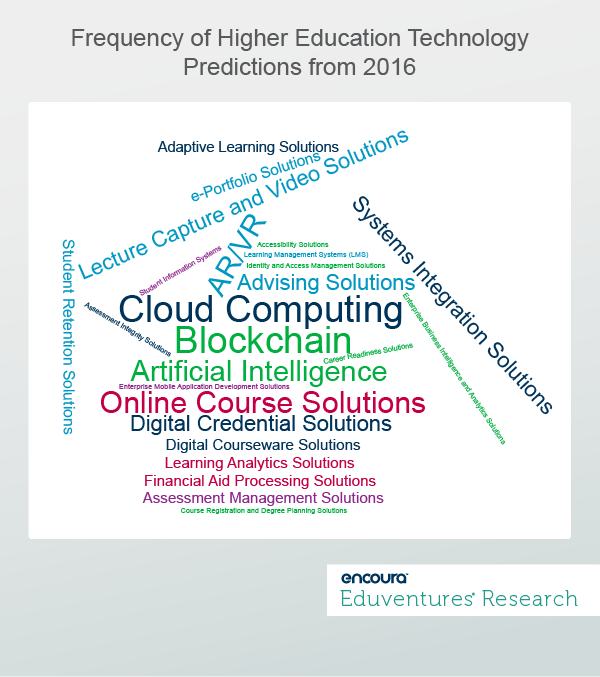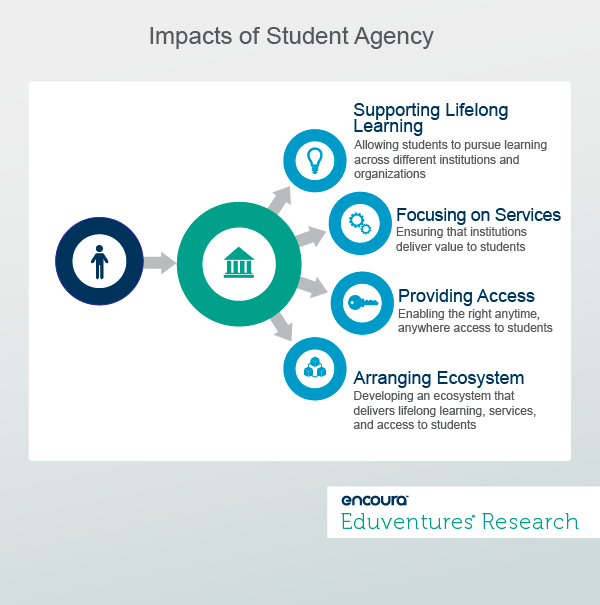We all love making predictions. They help us deal with uncertainty, which has undoubtedly come into sharp focus over the past year. The issue with predictions, however, is that they are often wrong—some glaringly so. And those involving higher education technology are no exception: just remember those projections about the supposed disruptive power of massive online open courses (MOOCs).
So, should we avoid making predictions about higher education technology? We think not. But we believe that forecasts should be less about hype and instead consider more profound shifts in user expectations and behavior. This week's Wake-Up Call will focus on one of these shifts: the demand for more student agency.
Looking Backward
In Figure 1, we show the frequency of forecasts made since 2016. We reviewed over 100 blog posts, scholarly papers, and articles. Our research revealed that cloud computing, blockchain, artificial intelligence, augmented or virtual reality (AR/VR), and online course solutions (MOOCs) were mentioned most frequently in articles focused on technology with the greatest future impact and traction in higher education.

Some of these predictions seem correct: as institutions look to develop more scalable and resilient ecosystems, higher education leaders have found some appealing cloud-based solutions (email, Student Information Systems, and Learning Management Systems, for example).
The jury, however, is still out on the integrity of other predictions, such as AR or VR and blockchain. Although the rationale for why institutions would adopt these solutions (improving skills-based learning or enabling the portability of student records) is compelling, higher education has yet to embrace large-scale adoption.
How do these predictions happen? Sometimes, those who predict the higher education market use investment flow to measure the market's future, assuming that venture capitalists and other investors are reading the trends correctly. In other cases, predictions follow the "build it, and they will come" approach, considering the innovative value of technology to be the thing that will drive adoption.
While these different approaches to making technology predictions make sense, they miss some fundamental sea changes that drive technology adoption. For example, as one chief information officer (CIO) said, the actual driver for cloud computing is not the technology itself, but what the technology allows the institution to do, i.e., like developing ecosystems that adapt and respond to changes in delivering institutional stakeholders' services.
So, which sea change do we As shown in Figure 2, we expect increasing importance placed on student demand for a greater voice and choice in how they learn.

This change, which we call "student agency," will have four consequential effects on what capabilities institutions must develop, and which technologies institutions must consider adopting:
- Supporting lifelong learning: As we wrote in a previous Wake-Up Call, an increasing number of institutions will consider how they can help students manage digital content across the teaching and learning ecosystem. Supporting lifelong learning requires that institutions provide a way for students to manage this content, regardless of who issued it or when students got it. As a result, we see technology segments like Digital Credentialing Solutions benefitting from this effect.
- Focusing on services: Greater student agency will compel institutions to improve the student experience by allowing students to achieve the outcomes they want (more straightforward access to financial aid information, for example). An ecosystem's goal is to provide students with seamless and valuable experiences throughout their journeys. This focus will spur the adoption of technologies such as Constituent Relationship Management solutions and Advising solutions. These serve as critical touchpoints between an institution and its students and, therefore, are crucial to the value of the student experience.
- Providing access: One component of student agency is easy, anytime, anywhere access to digital content. This access comes in two forms: how students logistically access content and how easily they can engage with content. The first comprises login requests, verification of student identities, and provision and control of student access to the right materials. The second involves access to content for all students—especially those with disabilities—without issues. Therefore, more institutions will adopt Identity and Access Management solutions and Accessibility Solutions to respond to this demand.
- Arranging the ecosystem: Supporting student agency is less about a single product than how the products fit together. For example, supporting lifelong learning will require that institutional leaders consider how their solutions integrate and share information to provide a seamless experience for students, gathering digital content from disparate locations. We see the Systems Integration Solutions segment benefitting the most from this effect.
The Bottom Line
While technology predictions are more art than science, we must start with the actual technological adoption drivers in higher education. Our approach seeks to point higher education leaders beyond the flow of investment dollars or technological novelty to identify and understand the deeper causes that might affect the market.
For more information about any of the technology segments mentioned in this post, download our Higher Education Technology Landscape image. Eduventures clients can also access the full Tech Landscape report on Encoura® Data Lab.
Never Miss Your Wake-Up Call
Learn more about our team of expert research analysts here.
Eduventures Principal Analyst at ACT | NRCCUA
Contact
Tuesday, January 19, 2021 at 2PM ET/1PM CT
You’ve already invested in digital media to enroll Gen Z. But how do you accurately measure the success of any one campaign and what metrics really matter as you look to improve engagement with prospective students?
Thursday, January 21, 2021 at 2PM ET/1PM CT
How should you transition from application to yield season in a year where students need more support than ever? What is the best way to support student decision making if you can only reach them virtually?

